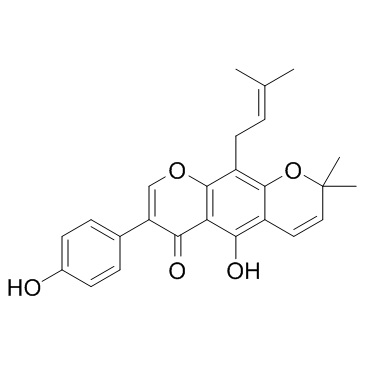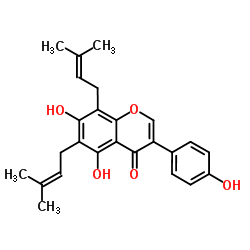4449-55-2
| Name | 5-hydroxy-7-(4-hydroxyphenyl)-2,2-dimethyl-10-(3-methylbut-2-enyl)pyrano[3,2-g]chromen-6-one |
|---|---|
| Synonyms |
2H,6H-Benzo[1,2-b:5,4-b']dipyran-6-one, 5-hydroxy-7-(4-hydroxyphenyl)-2,2-dimethyl-10-(3-methyl-2-butenyl)-
2H,6H-Benzo[1,2-b:5,4-b']dipyran-6-one, 5-hydroxy-7-(4-hydroxyphenyl)-2,2-dimethyl-10-(3-methyl-2-buten-1-yl)- 5-Hydroxy-7-(4-hydroxyphenyl)-2,2-dimethyl-10-(3-methyl-2-buten-1-yl)-2H,6H-pyrano[3,2-g]chromen-6-one 2H,6H-Benzo[1,2-b:5,4-b']dipyran-6-one, 5-hydroxy-7-(p-hydroxyphenyl)-2,2-dimethyl-10-(3-methyl-2-butenyl)- 5-Hydroxy-7-(4-hydroxyphenyl)-2,2-dimethyl-10-(3-methylbut-2-en-1-yl)-2H,6H-pyrano[3,2-g]chromen-6-one Warangalone Scandenone 2H,6H-Benzo(1,2-b:5,4-b')dipyran-6-one, 5-hydroxy-7-(4-hydroxyphenyl)-2,2-dimethyl-10-(3-methyl-2-butenyl)- Scandenolone |
| Description | Warangalone is an anti-malarial compound which can inhibit the growth of both strains of parasite 3D7 (chloroquine sensitive) and K1 (chloroquine resistant) with IC50s of 4.8 μg/mL and 3.7 μg/mL, respectively. Warangalone can also inhibit cyclic AMP-dependent protein kinase catalytic subunit (cAK) with an IC50 of 3.5 μM. |
|---|---|
| Related Catalog | |
| Target |
IC50: 4.8 μg/mL (3D7), 3.7 μg/mL (K1)[1] IC50: 3.5 μM (cAK)[2] |
| In Vitro | Warangalone is an anti-malarial compound which can inhibit the growth of both strains of parasite 3D7 (chloroquine sensitive) and K1 (chloroquine resistant) with IC50s of 4.8 μg/mL and 3.7 μg/mL, respectively[1]. Warangalone can also inhibit cyclic AMP-dependent protein kinase catalytic subunit (cAK) with an IC50 of 3.5 μM[2]. When HL-60 cells are exposed to Warangalone (30 μM) for 24 h, Warangalone induces a significant decrease (8%) in cell viability compare to controls. Warangalone also inhibits HL-60 cell growth within 24 h in a time-dependent fashion. A time-dependent increase in caspase-9 activity is observed in Warangalone-treated cells[3]. |
| Kinase Assay | The enzyme activities of caspase-3 and caspase-9 are measured using a caspase fluorometric assay kit. Cells are seeded in 24-well plates at a density of 3×106 cells per well. After exposure of the cells to Warangalone for the allotted time periods, the cells are washed three times with PBS, and then lysed in a lysis buffer for 10 min on ice. The protein content of the cell lysates is assayed with a Micro BCA reagent. Cell lysates containing 50 μg of protein are incubated with a caspase-3 fluorogenic substrate (DEVD-AFC) or a caspase-9 fluorogenic substrate (LEHD-AFC) for 1 h at 37°C. Caspase activity is measured by fluorometric detection[3]. |
| Cell Assay | Cell viability is determined using the Cell Titer 96 Aqueous assay kit. Cells are seeded in 96-well plates at a density of 1×105 cells per well. The cells are maintained for 24 h at 37°C and then Warangalone (30 μM) is added to the culture medium. MTS solution is added to the 96-well plates at the indicated time points, and the cells are incubated for 1 h at 37°C. The absorbance is measured at a wavelength of 490 nm with a microplate counter[3]. |
| References |
| Density | 1.3±0.1 g/cm3 |
|---|---|
| Boiling Point | 627.0±55.0 °C at 760 mmHg |
| Molecular Formula | C25H24O5 |
| Molecular Weight | 404.455 |
| Flash Point | 216.7±25.0 °C |
| Exact Mass | 404.162384 |
| PSA | 79.90000 |
| LogP | 7.87 |
| Vapour Pressure | 0.0±1.9 mmHg at 25°C |
| Index of Refraction | 1.628 |
|
~% 
4449-55-2 |
| Literature: Singhal, Ashok K.; Sharma, Ram P.; Thyagarajan, Gopalakrishna; Herz, Werner; Govindan, Serengolam V. Phytochemistry (Elsevier), 1980 , vol. 19, p. 929 - 934 |
| Precursor 1 | |
|---|---|
| DownStream 0 | |


